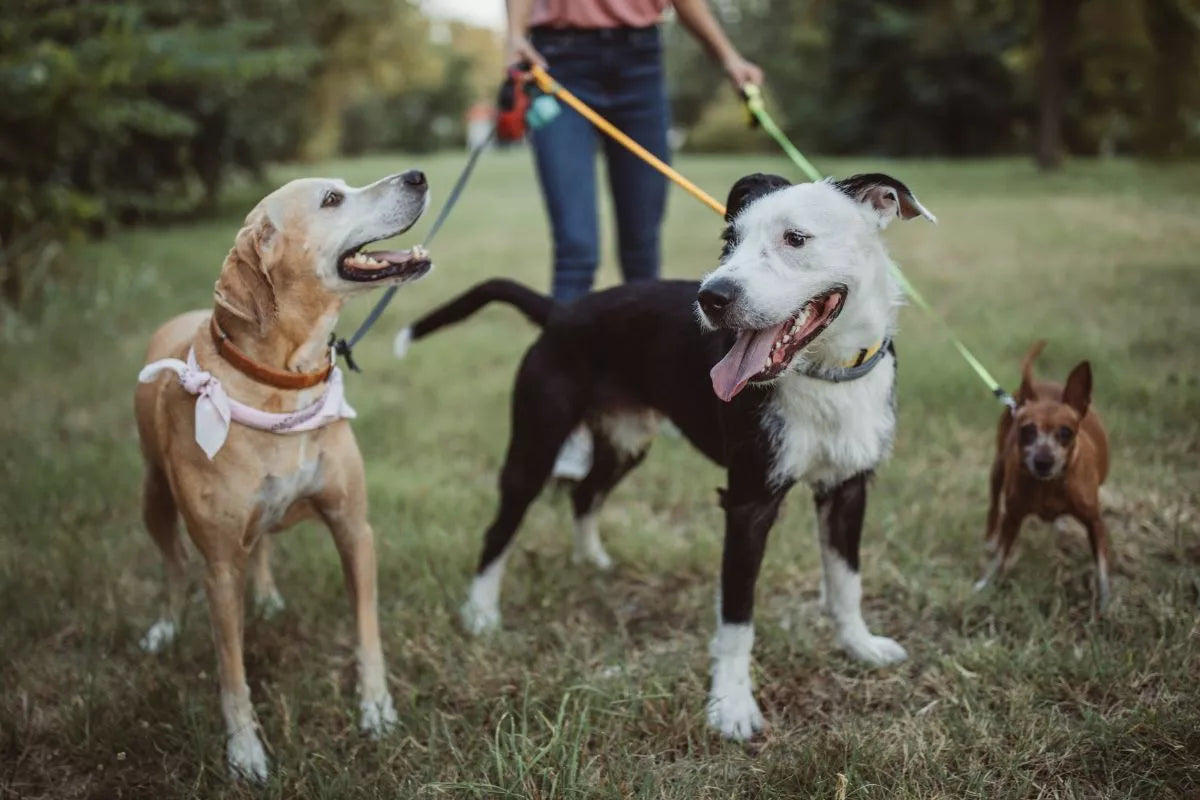Your Dog's Behaviour On Walks - Tiredness, boredom, Age, Anxiety?

There are several signs that can indicate if your dog is tired during a walk. But is your dog's behaviour always down to tiredness? Here are a few things to help make sense of your dog's behaviour when out walking.
If your dog starts to walk more slowly than usual or lags behind, it could be a sign of fatigue. However, there could also be other reasons behind this behaviour. Here are a few things to consider.
Is your dog Overheating: Dogs are more susceptible to overheating than humans due to their limited ability to cool down. If it's a hot day or the walking surface is too hot, your dog may slow down as a way to regulate their body temperature and prevent heat exhaustion or heatstroke. Ensure your dog has access to shade, carry water for hydration, and consider walking during cooler times of the day.
Age or Health Issues: Senior dogs or dogs with underlying health conditions may experience reduced stamina and mobility. Slowing down during walks could be a sign of arthritis, joint pain, muscle weakness, or other age-related issues. If you notice consistent slowing down or any other concerning symptoms, it's advisable to consult with a veterinarian to assess your dog's health and determine appropriate care.
Mental Stimulation: Dogs not only need physical exercise but also mental stimulation during walks. If the walk lacks opportunities for sniffing, exploring, and interacting with the environment, your dog may lose interest and slow down. Consider incorporating engaging activities, such as hiding treats or practicing obedience commands, to keep your dog mentally stimulated during the walk.
Anxiety or Fear: Dogs that are anxious or fearful may slow down or freeze during walks as a response to perceived threats or discomfort. It's important to observe their body language for signs of anxiety, such as cowering, tail tucking, or avoidance behaviors. If anxiety is a concern, consulting with a professional dog trainer or behaviorist can help address the underlying issues.
Dogs regulate their body temperature through panting, but excessive and heavy panting can be a sign of exhaustion. If your dog is panting excessively and struggling to catch its breath, it may be time to take a break.
While heavy panting can be a sign of tiredness, it can also indicate other factors such as:
Heat exhaustion: Dogs can overheat quickly, especially in hot and humid weather. If the panting is accompanied by excessive drooling, glazed eyes, weakness, or disorientation, it could be a sign of heat exhaustion or heatstroke. In such cases, it's crucial to find shade, offer water, and seek immediate veterinary attention.
Stress or anxiety: Panting can also be a response to stress or anxiety. If your dog is uncomfortable or fearful during walks, they may pant heavily as a way to cope with those emotions.
Physical discomfort or pain: If your dog is panting heavily and showing signs of lameness, stiffness, or discomfort in their movements, it could be an indication of pain or an underlying health issue. In such cases, it's important to consult with your veterinarian to rule out any medical conditions.
If your dog starts seeking shady spots or lying down frequently during the walk, it's a sign that they may be tired and need a rest. However, it could also indicate a few different things:
Fatigue: Dogs, just like humans, can become tired during physical activity. If your dog has been walking for a while or engaging in strenuous exercise, they may choose to lie down to rest and recover their energy.
Heat or Overheating: Dogs regulate their body temperature through panting and seeking shade. If it's a hot day or your dog is overheating, they may lie down to cool off or find a cooler surface. Heat exhaustion or heatstroke can be dangerous, so it's important to monitor your dog closely in hot weather and provide them with plenty of water and shade.
Discomfort or Pain: If your dog suddenly lies down and appears reluctant to continue walking, it could be a sign of discomfort or pain. Dogs may lie down to alleviate pressure on sore joints, muscles, or injuries. It's important to observe their overall behavior and look for other signs of pain or discomfort, such as limping, stiffness, or reluctance to move.
Anxiety or Fear: Some dogs may lie down during a walk if they are feeling anxious, stressed, or fearful. It can be a way for them to signal that they are uncomfortable or want to avoid certain situations. This behavior may be accompanied by other signs of anxiety, such as panting, trembling, or avoidance behaviors.
A tired dog may lose interest in their surroundings and start to sniff excessively. This behavior can be a way for them to slow down and take a break. Also, if they are showing these signs it could also be:
A Lack of Stimulation: Dogs thrive on mental and physical stimulation. If your walks are monotonous, lack variety, or fail to provide enough opportunities for exploration and interaction, your dog may become disinterested. Dogs enjoy sniffing, investigating their surroundings, and encountering new sights, sounds, and smells. Consider incorporating interactive games, training exercises, or new routes to make the walks more engaging for your dog.
Distractions or Overstimulation: Depending on the environment, there might be distractions that divert your dog's attention away from the walk. It could be other animals, strong scents, loud noises, or unfamiliar surroundings. These distractions can cause your dog to become disinterested or anxious. Gradually exposing your dog to different environments and gradually desensitizing them to potential triggers can help improve their focus and engagement during walks.
Medical Issues: It's important to consider any underlying health issues that may be causing your dog's disinterest. If your dog is experiencing pain, discomfort, or illness, they may not have the energy or desire to participate in walks. If you suspect a health concern, it's best to consult with your veterinarian to rule out any medical issues.
Behavioral or Emotional Factors: Disinterest during walks can sometimes be a manifestation of behavioral or emotional issues. It could be due to anxiety, fear, stress, or even depression. If your dog consistently displays disinterest or exhibits other concerning behaviors, consulting a professional dog trainer or animal behaviorist can provide valuable insights and guidance.
If your dog starts to pull towards home or shows little interest in continuing the walk, it could be a sign that they've had enough exercise and are ready to rest. Remember, if your dog is pulling towards home early on in the walk, this could also be down to:
Routine and Familiarity: Dogs are creatures of habit and may associate certain routes or locations with the comfort and familiarity of home. They might be eager to return to a known environment where they feel safe and secure.
Fatigue or Discomfort: If your dog is tired or experiencing physical discomfort, they may pull towards home as a way to seek rest or relief. This could be due to exhaustion from a long walk or discomfort from an underlying health issue. Observing other signs of fatigue or discomfort, such as panting, slowing down, or lagging behind, can help determine if this is the case.
Separation Anxiety: Some dogs experience separation anxiety when separated from their owners or their home environment. Pulling towards home could be a sign of their desire to be in a familiar and secure place. Separation anxiety may manifest as other behaviors such as whining, restlessness, or destructive behavior when away from home.
Lack of Interest or Stimulation: If your dog finds the walk uninteresting or lacks stimulation, they may pull towards home in search of more engaging activities or familiar surroundings. Dogs thrive on mental and physical stimulation, so ensuring that the walk provides enough opportunities for exploration, sniffing, and interaction can help alleviate their desire to head back home.
Training or Reinforcement: If your dog has been inadvertently reinforced or rewarded for pulling towards home in the past, they may continue the behavior. For example, if you've given in to their pulling and turned back home as a result, they may have learned that pulling gets them what they want.
Pay attention to any changes in your dog's gait or posture. If they start to stumble, walk with a slouched back, or show signs of stiffness, it could indicate fatigue or potential discomfort. Providing opportunities for rest and adjusting the intensity or duration of the walk to match your dog's stamina can help prevent excessive fatigue. Other things to consider include:
Discomfort or Pain: A change in posture during a walk could indicate that your dog is experiencing discomfort or pain. They may alter their posture to alleviate pressure or avoid putting weight on certain areas. It's essential to observe for other signs of discomfort, such as limping, reluctance to move, stiffness, or any unusual sensitivity when touched. If you suspect your dog is in pain, consulting with a veterinarian is recommended.
Environmental Factors: Changes in posture could also be influenced by environmental factors. For instance, if your dog encounters unfamiliar or potentially threatening stimuli, they may adopt a defensive posture to signal discomfort or a desire to avoid the situation. Similarly, extreme weather conditions, such as strong winds or slippery surfaces, may cause your dog to adjust their posture for stability and balance.
Behavioral Factors: In some cases, a change in posture during a walk may be influenced by behavioral or emotional factors. Dogs that are anxious, fearful, or stressed may display tense body postures, lowered heads, or crouching positions as a response to their emotional state. If you suspect your dog's posture changes are due to behavioral factors, consulting with a professional dog trainer or behaviorist can help address the underlying issues.
It's essential to monitor your dog's energy levels and behavior during walks, especially in hot weather or if they have any health conditions. Always prioritize their well-being and provide opportunities for rest and hydration when needed.
Slowing down
If your dog starts to walk more slowly than usual or lags behind, it could be a sign of fatigue. However, there could also be other reasons behind this behaviour. Here are a few things to consider.
Is your dog Overheating: Dogs are more susceptible to overheating than humans due to their limited ability to cool down. If it's a hot day or the walking surface is too hot, your dog may slow down as a way to regulate their body temperature and prevent heat exhaustion or heatstroke. Ensure your dog has access to shade, carry water for hydration, and consider walking during cooler times of the day.
Age or Health Issues: Senior dogs or dogs with underlying health conditions may experience reduced stamina and mobility. Slowing down during walks could be a sign of arthritis, joint pain, muscle weakness, or other age-related issues. If you notice consistent slowing down or any other concerning symptoms, it's advisable to consult with a veterinarian to assess your dog's health and determine appropriate care.
Mental Stimulation: Dogs not only need physical exercise but also mental stimulation during walks. If the walk lacks opportunities for sniffing, exploring, and interacting with the environment, your dog may lose interest and slow down. Consider incorporating engaging activities, such as hiding treats or practicing obedience commands, to keep your dog mentally stimulated during the walk.
Anxiety or Fear: Dogs that are anxious or fearful may slow down or freeze during walks as a response to perceived threats or discomfort. It's important to observe their body language for signs of anxiety, such as cowering, tail tucking, or avoidance behaviors. If anxiety is a concern, consulting with a professional dog trainer or behaviorist can help address the underlying issues.
Heavy panting
Dogs regulate their body temperature through panting, but excessive and heavy panting can be a sign of exhaustion. If your dog is panting excessively and struggling to catch its breath, it may be time to take a break.
While heavy panting can be a sign of tiredness, it can also indicate other factors such as:
Heat exhaustion: Dogs can overheat quickly, especially in hot and humid weather. If the panting is accompanied by excessive drooling, glazed eyes, weakness, or disorientation, it could be a sign of heat exhaustion or heatstroke. In such cases, it's crucial to find shade, offer water, and seek immediate veterinary attention.
Stress or anxiety: Panting can also be a response to stress or anxiety. If your dog is uncomfortable or fearful during walks, they may pant heavily as a way to cope with those emotions.
Physical discomfort or pain: If your dog is panting heavily and showing signs of lameness, stiffness, or discomfort in their movements, it could be an indication of pain or an underlying health issue. In such cases, it's important to consult with your veterinarian to rule out any medical conditions.
Seeking shade or lying down
If your dog starts seeking shady spots or lying down frequently during the walk, it's a sign that they may be tired and need a rest. However, it could also indicate a few different things:
Fatigue: Dogs, just like humans, can become tired during physical activity. If your dog has been walking for a while or engaging in strenuous exercise, they may choose to lie down to rest and recover their energy.
Heat or Overheating: Dogs regulate their body temperature through panting and seeking shade. If it's a hot day or your dog is overheating, they may lie down to cool off or find a cooler surface. Heat exhaustion or heatstroke can be dangerous, so it's important to monitor your dog closely in hot weather and provide them with plenty of water and shade.
Discomfort or Pain: If your dog suddenly lies down and appears reluctant to continue walking, it could be a sign of discomfort or pain. Dogs may lie down to alleviate pressure on sore joints, muscles, or injuries. It's important to observe their overall behavior and look for other signs of pain or discomfort, such as limping, stiffness, or reluctance to move.
Anxiety or Fear: Some dogs may lie down during a walk if they are feeling anxious, stressed, or fearful. It can be a way for them to signal that they are uncomfortable or want to avoid certain situations. This behavior may be accompanied by other signs of anxiety, such as panting, trembling, or avoidance behaviors.
Excessive sniffing or disinterest
A tired dog may lose interest in their surroundings and start to sniff excessively. This behavior can be a way for them to slow down and take a break. Also, if they are showing these signs it could also be:
A Lack of Stimulation: Dogs thrive on mental and physical stimulation. If your walks are monotonous, lack variety, or fail to provide enough opportunities for exploration and interaction, your dog may become disinterested. Dogs enjoy sniffing, investigating their surroundings, and encountering new sights, sounds, and smells. Consider incorporating interactive games, training exercises, or new routes to make the walks more engaging for your dog.
Distractions or Overstimulation: Depending on the environment, there might be distractions that divert your dog's attention away from the walk. It could be other animals, strong scents, loud noises, or unfamiliar surroundings. These distractions can cause your dog to become disinterested or anxious. Gradually exposing your dog to different environments and gradually desensitizing them to potential triggers can help improve their focus and engagement during walks.
Medical Issues: It's important to consider any underlying health issues that may be causing your dog's disinterest. If your dog is experiencing pain, discomfort, or illness, they may not have the energy or desire to participate in walks. If you suspect a health concern, it's best to consult with your veterinarian to rule out any medical issues.
Behavioral or Emotional Factors: Disinterest during walks can sometimes be a manifestation of behavioral or emotional issues. It could be due to anxiety, fear, stress, or even depression. If your dog consistently displays disinterest or exhibits other concerning behaviors, consulting a professional dog trainer or animal behaviorist can provide valuable insights and guidance.
Lagging behind or pulling towards home
If your dog starts to pull towards home or shows little interest in continuing the walk, it could be a sign that they've had enough exercise and are ready to rest. Remember, if your dog is pulling towards home early on in the walk, this could also be down to:
Routine and Familiarity: Dogs are creatures of habit and may associate certain routes or locations with the comfort and familiarity of home. They might be eager to return to a known environment where they feel safe and secure.
Fatigue or Discomfort: If your dog is tired or experiencing physical discomfort, they may pull towards home as a way to seek rest or relief. This could be due to exhaustion from a long walk or discomfort from an underlying health issue. Observing other signs of fatigue or discomfort, such as panting, slowing down, or lagging behind, can help determine if this is the case.
Separation Anxiety: Some dogs experience separation anxiety when separated from their owners or their home environment. Pulling towards home could be a sign of their desire to be in a familiar and secure place. Separation anxiety may manifest as other behaviors such as whining, restlessness, or destructive behavior when away from home.
Lack of Interest or Stimulation: If your dog finds the walk uninteresting or lacks stimulation, they may pull towards home in search of more engaging activities or familiar surroundings. Dogs thrive on mental and physical stimulation, so ensuring that the walk provides enough opportunities for exploration, sniffing, and interaction can help alleviate their desire to head back home.
Training or Reinforcement: If your dog has been inadvertently reinforced or rewarded for pulling towards home in the past, they may continue the behavior. For example, if you've given in to their pulling and turned back home as a result, they may have learned that pulling gets them what they want.
Changes in gait or posture
Pay attention to any changes in your dog's gait or posture. If they start to stumble, walk with a slouched back, or show signs of stiffness, it could indicate fatigue or potential discomfort. Providing opportunities for rest and adjusting the intensity or duration of the walk to match your dog's stamina can help prevent excessive fatigue. Other things to consider include:
Discomfort or Pain: A change in posture during a walk could indicate that your dog is experiencing discomfort or pain. They may alter their posture to alleviate pressure or avoid putting weight on certain areas. It's essential to observe for other signs of discomfort, such as limping, reluctance to move, stiffness, or any unusual sensitivity when touched. If you suspect your dog is in pain, consulting with a veterinarian is recommended.
Environmental Factors: Changes in posture could also be influenced by environmental factors. For instance, if your dog encounters unfamiliar or potentially threatening stimuli, they may adopt a defensive posture to signal discomfort or a desire to avoid the situation. Similarly, extreme weather conditions, such as strong winds or slippery surfaces, may cause your dog to adjust their posture for stability and balance.
Behavioral Factors: In some cases, a change in posture during a walk may be influenced by behavioral or emotional factors. Dogs that are anxious, fearful, or stressed may display tense body postures, lowered heads, or crouching positions as a response to their emotional state. If you suspect your dog's posture changes are due to behavioral factors, consulting with a professional dog trainer or behaviorist can help address the underlying issues.
It's essential to monitor your dog's energy levels and behavior during walks, especially in hot weather or if they have any health conditions. Always prioritize their well-being and provide opportunities for rest and hydration when needed.
-
Posted in
dog walking behaviour, what does my dogs behaviour mean when walking, whay does my dog lie down on walks, why does my dog pull for home when walking, why does my dog sniff so much on walks, why is my dog tired on walks





